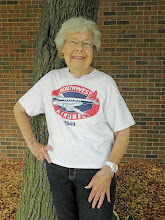Leaving NWA 188 behind . . . and welcoming instead a true NWA pioneer, Phyllis Curry
Whenever I grow weary of the incredible events ever-unfolding in 2009-era commercial aviation, I take refuge in tales of earlier times. Today is such a day. Even though newspapers are still publishing cartoons and late-night TV jesters are still poking fun at a couple of hapless NWA pilots, I say, "enough already." Their legacy is cast in stone. They will forever be known as the pilots who overflew their destination and had virtually the whole country looking for them and their clueless 147 passengers and cabin crew, while they dallied on their laptops. Their fate is sealed. They have become, forevermore, a trivia question. 

A couple of weeks back I had the pleasure of meeting Phyllis Curry, pictured above in 1947 with her soon to be husband, pilot Charles Curry. She was one of the first NWA stewardesses to work flights from MSP to Tokyo after World War II, shortly after NWA began flying the "Inside Circle"route in July, 1947.
Jessie McCloud was Chief Stewardess at the time, and the company decided to hand-pick the new "Orient" route cabin crews from the roster, not based on seniority. (I wonder how they got away with that?) Initially they were looking for four stewardesses. Phyllis applied, but wasn't accepted. The route proved successful. They needed four more stewardesses. Phyllis was called for the second round of hiring and was selected. The uniform worn by this elite group included a distinctive hat (see above) made especially for the Orient crews. Phyllis admits ruefully that she has been approached by many collectors and museums over the years looking for one of those extremely rare hats and she has no idea what happened to hers. She figures they were given to no more than 20 women in all, who wore them proudly on other NWA flights as well.
There will be more on the MSP-Tokyo route in my next post. For "teaser" purposes, let me give you a peek; the aircraft used on these flights was the venerable, but unpressurized, Douglas DC-4. Flight time was a mere 33 hours. Stops were made in Edmonton or Anchorage, and crews laid over in Shemya; at the end of the Aleutian Islands, the western-most tip of the U.S. (not a good place to over-fly.) Crew layovers were typically two days in a place so barren and harsh the snow was blown horizontally by ceaseless winds. Stay tuned . . .






1 Comments:
Really looking forward to the original posts about Phyllis.
Post a Comment
Subscribe to Post Comments [Atom]
<< Home